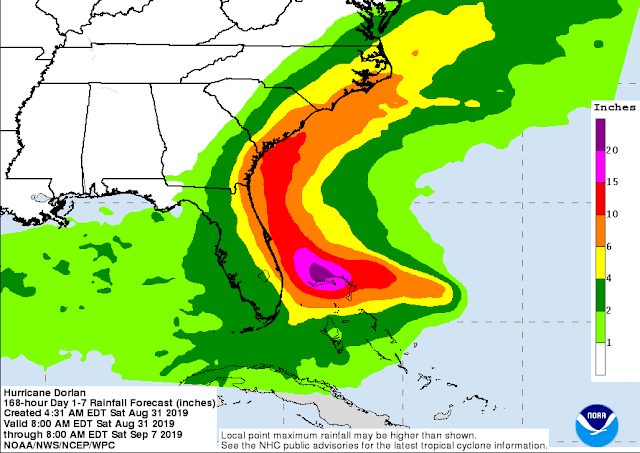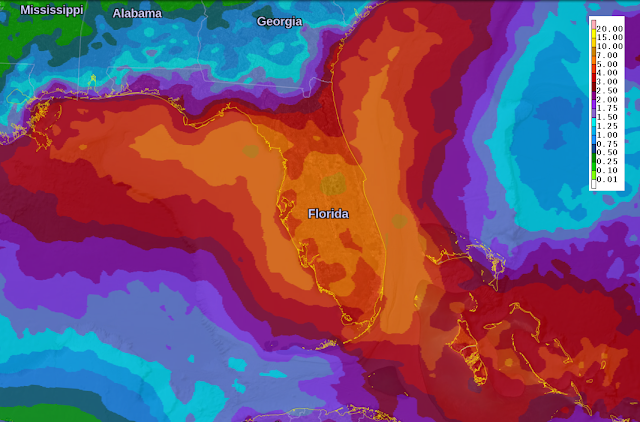Since my previous update on Friday, the disturbance in the deep tropics was upgraded to Tropical Depression 5 on Saturday morning, then to Tropical Storm Dorian on Saturday afternoon. Dorian is the 4th named storm of the Atlantic season.
The wave that would become Dorian left the African coast a week ago today and has been a feature of interest since then. This is the time of year when most of the named storms have an African pedigree.
As I mentioned on Friday, this storm has not had the most ideal of environmental conditions to deal with, so it has been slow to develop. As of 8am EDT on Monday, it's a tropical storm with 60 mph sustained winds and is centered about 300 miles east of the Windward Islands in the Lesser Antilles. The latest forecast from
NHC indicates that it could reach hurricane intensity later this week in the central Caribbean. However, model guidance is
very split on its future beyond Thursday.
This also seems like a good time to bring back the
Cone of Uncertainty Update & Refresher... many people misinterpret what the cone shown above is intended to tell them and what's it's NOT intended to tell them! The key messages:
- The forecast not is not an impacts cone.
- The forecast cone does not show the size of the storm.
- The forecast cone is identical for every forecast of every storm all season long, so it does not represent actual uncertainty/predictability of a specific storm.
- The forecast cone only shows where the center of the storm could track 2/3 of the time, using the previous five years of NHC average track errors.
Please read the blog post linked above for more details.
OK, back to Dorian.
It is getting better organized on Monday, and it has another couple of days before the vertical wind shear is expected to become more hostile, which is also roughly when it would start interacting with Puerto Rico and/or Hispaniola. Those mountainous islands will further disrupt Dorian's circulation. In the meantime, it will also have to contend with a lot of dry air that has has surrounded it for days. So it remains to be seen what's left intact by Friday morning, and that will have consequences for the Bahamas, south Florida, and other nearby places.
Long-range models have been in good agreement for several days that
something will track over the Bahamas and toward or over Florida, but that "something" varies from a tropical wave to a minimal hurricane, with the most likely somewhere in between (tropical depression or tropical storm). The timing for Florida would be Saturday-Sunday, but at this point, it's no cause for concern.
In the maps below, track and intensity forecasts from two global models and their ensembles (the European ECMWF and the American GFS) are shown. The tracks are color-coded by intensity. As always, keep in mind that these are not official forecasts, but the most recent possible scenarios from two leading models going out ten days. The spread in track and intensity -- and its trend -- is useful information when interpreting the output and how much to trust it.
So, for now, the primary threat is in the Lesser Antilles where tropical storm watches and warnings are in effect, and could even be upgraded to hurricane watches and warnings today if Dorian continues to intensify.
Elsewhere, the basin is relatively quiet. The disturbance that was off the southeast Florida coast on Friday is still close to becoming a tropical or subtropical cyclone, but is now centered well off the southeast US coast and headed toward Bermuda. It could get upgraded to TD/STD 6 or TS/STS Erin any time now.











 On Wednesday, Dorian did end up tracking far enough east of Puerto Rico that the storm's circulation was not affected at all... in fact, it strengthened into the season's second hurricane right as it passed by the island. As of 8am EDT on Thursday, it is a Category 1 hurricane with 85 mph sustained winds and is centered 150 miles north of Puerto Rico, and 1000 miles southeast of Cape Canaveral FL. Tropical storm force winds only extend an average of 60 miles from the center, but storms typically gradually expand with time.
On Wednesday, Dorian did end up tracking far enough east of Puerto Rico that the storm's circulation was not affected at all... in fact, it strengthened into the season's second hurricane right as it passed by the island. As of 8am EDT on Thursday, it is a Category 1 hurricane with 85 mph sustained winds and is centered 150 miles north of Puerto Rico, and 1000 miles southeast of Cape Canaveral FL. Tropical storm force winds only extend an average of 60 miles from the center, but storms typically gradually expand with time.



 Tropical Storm Dorian remains the primary feature of interest in the Atlantic. It is strengthening in the northeast Caribbean and will pass close to Puerto Rico today as a borderline hurricane. As of 11am EDT, the sustained winds are up to 70 mph and it's centered over St. Croix.
Tropical Storm Dorian remains the primary feature of interest in the Atlantic. It is strengthening in the northeast Caribbean and will pass close to Puerto Rico today as a borderline hurricane. As of 11am EDT, the sustained winds are up to 70 mph and it's centered over St. Croix.





















 Chantal, the season's third named storm, formed on Tuesday night in the north-central Atlantic. As of Wednesday morning, it's a tropical storm with 40 mph sustained winds centered 450 miles south of Newfoundland.
Chantal, the season's third named storm, formed on Tuesday night in the north-central Atlantic. As of Wednesday morning, it's a tropical storm with 40 mph sustained winds centered 450 miles south of Newfoundland.


